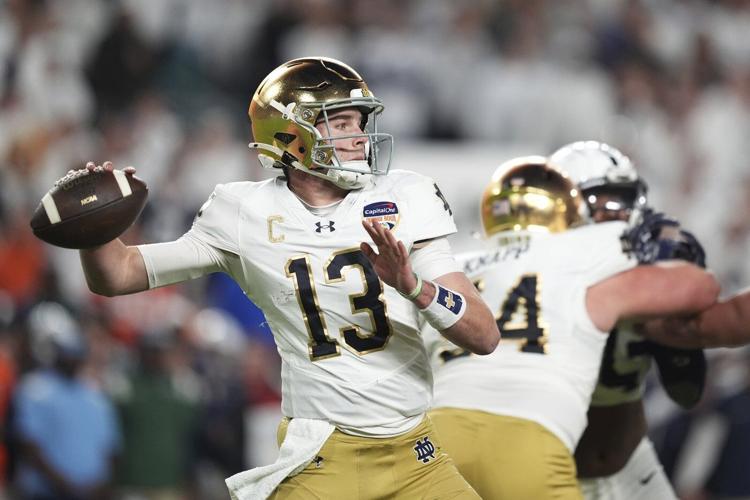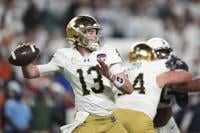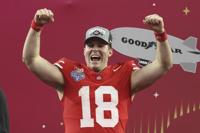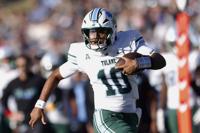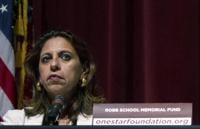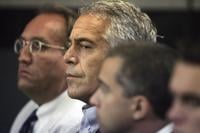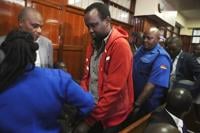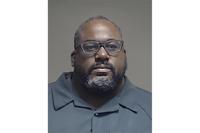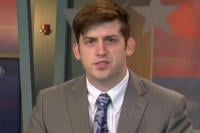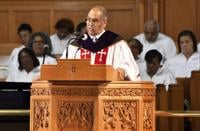ATLANTA (AP) — A quarterback moving from Tulane to Duke doesn't raise eyebrows. The $8 million that boosters at a basketball school paid for a football player does.
A veteran NFL coach finding a career lifeline at a college program that doesn't win a lot shouldn't surprise anyone. It does feel like a shock that the coach is Pro Football Hall of Fame-bound Bill Belichick.
Transactions nobody ever dreamed of became everyday occurrences this season in college football's trip through the looking glass. Even so, one of the most tumultuous years in history will end with two schools whose traditions are as old as the game itself — Ohio State and Notre Dame — .
Monday night's final (even that's a fairly novel concept for a sport defined by its bowl games for decades) will mark the latest finish to a season in college football's 155-year history. It's a product of the new 12-team playoff worth billions.
What comes after the game — with player payments, the transfer portal, tweaks to the playoff, Title IX issues and more — will determine how much wackiness persists next year and beyond.
“It’s a lot to consider, it’s a lot to try to navigate,” said Illinois athletic director Josh Whitman, who is the chair of the NCAA’s Division I policymaking board. “It’s hard, because you have a sense of what’s coming, but you don’t have as much clarity as you’d like.”
A quarterback’s journey tells a story no one could imagine five years ago
What better way to illustrate these changing times than by telling the story of quarterback Darian Mensah.
He was a two-star recruit out of California in high school who got scholarship offers from three schools: San Jose State, Lindenwood (in Missouri) and Tulane. He chose Tulane and threw for 2,723 yards and 22 touchdowns. He kept the Green Wave in the College Football Playoff conversation through much of the year.
Then, in December, with the transfer portal open and players leaving their schools for better offers in droves, in swooped a third-party collective affiliated with Duke.
A school known for basketball was who will reportedly receive $8 million — a record, but one that probably will be broken soon.
“It’s a prestigious university, and a great education is also important to me,” Mensah said. “It’s just a family out here. I wanted to be part of that.”
That Duke family, never considered the cradle of quarterbacks, has nonetheless lost two starters to the portal in two years. One of them is Riley Leonard, who will start Monday in the final for Notre Dame.
College looks like the pros, so Belichick takes the leap to Carolina
Perhaps an even bigger head-scratcher had to do not with a player but rather a coach.
Why would Bill Belichick, an out-of-work 72-year-old and owner six Super Bowl rings with the New England Patriots, give up on returning to the NFL to run a college program with scant tradition and coming off a soap opera-y firing of its coach, Mack Brown?
Well, Belichick's dad coached there in the 1950s. And in his , Belichick insisted he’d always wanted to coach college ball. More enlightening was what he told Pat McAfee while the negotiations were ongoing: That college football was starting to look very much like the pros.
“It would be a professional program — training, nutrition, scheme, coaching, techniques — that would transfer to the NFL,” Belichick said.
All this change, but some things stay the same at the top
All these players moving. All this budding talent showing up at places never known for football. It seems like any school can go from nothing into a college football powerhouse now, right?
Well, maybe not so fast. Even though the Southeastern Conference, which had won six of the last nine national titles, , Ohio State (five titles) and Notre Dame (11) are hardly new to this.
Some of the teams in the newly expanded playoff were not regulars — see Boise State, Indiana and Arizona State. But by the time the field had whittled to four, it was four traditional programs with national followings left standing: Penn State, Texas, the Buckeyes and the Fighting Irish.
“Everything is about recruitment and development and, now, retention,” said Indiana coach Curt Cignetti, reflecting on what it takes to stay at the top. “Every year you’ve got to start over now in college football. It’s not quite the NFL, but it’s getting close.”
All the madness, with more uncertainty to come
Among the questions that don’t have answers yet:
—The transfer portal: Most coaches detest the December window for players to transfer. It was set up with the school calendar in mind — if education matters, then players should have time to enroll for the spring semester at their new school — but also promotes players leaving before their seasons are over.
“At some point we need to look at our whole system so we can avoid circumstances like that because that was not fair to anybody involved,” said Iowa coach Kirk Ferentz, who was hardly an outlier after losing more than a dozen players to the portal.
—Roster limits: The soon-to-be-adopted 105-player limit for football means schools can give 20 more scholarships, but this ultimately will cut the number of total roster spots, a few dozen of which go to walk-ons. The same will happen on a
—Player payments and Title IX: Under terms of the that is reshaping college sports, schools were pivoting toward paying players directly for their name, image and likeness (NIL) beginning next year. Then came Thursday’s that those payments had to be treated the same as financial assistance. That means if schools spend most of the $20.5 million they’re allowed on male athletes, they’ll be in violation of Title IX.
“We’ve been building plans on top of plans for some time now,” said Whitman, the AD at Illinois. “And this is the most recent example of where we’re going to take the guidance under advisement and figure out what, if any, changes we have to make to the strategies we’ve developed.”
—Future of the playoff: Oh, the games. Generally, the rollout of the 12-team playoff has been viewed as a success, though tweaks in the way teams are seeded feel necessary. But it would take a unanimous vote of the 11-person board of the College Football Playoff, which meets Sunday, to make an adjustment.
Coaches agree, the game will never be the same
Missouri coach Eli Drinkwitz says the confusion over the House settlement, combined with constant threats about lawsuits and a dispersed array of decision-makers — the NCAA, conference commissioners, athletic directors — makes the entire industry hard to understand.
“I worry that the game that I love and have dedicated 30 something years of my life to is slowly getting taken away from us,” he said.
But at the core, all these changes are coming against the backdrop of something that felt long overdue: Players have a right to make money for the product they produce. That product is placing record amounts of money into school coffers, even if all of it is creating chaos.
“I’m an optimist. I think we’re moving in the right direction,” Ferentz said. “I think the proposed model right now is solid. The question is, can we enforce it, really make it a reality? I’ll believe that when I see it.”
___
AP Sports Writer Teresa Walker in Nashville, Tennessee, contributed to this report.
___
Get poll alerts and updates on the AP Top 25 throughout the season. Sign up . AP college football: and

